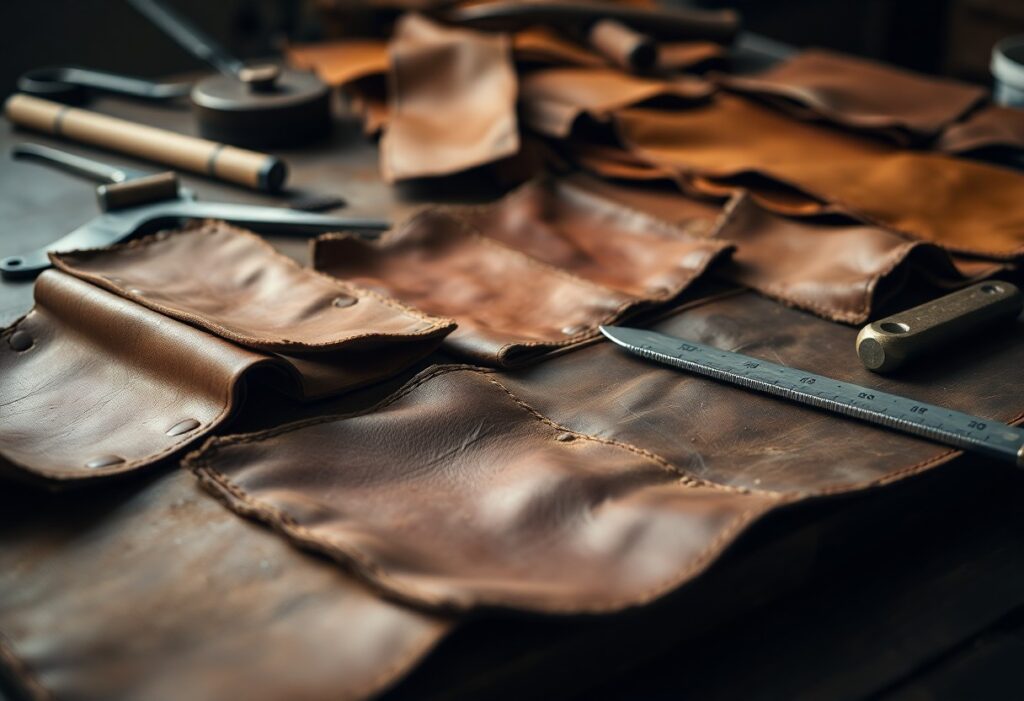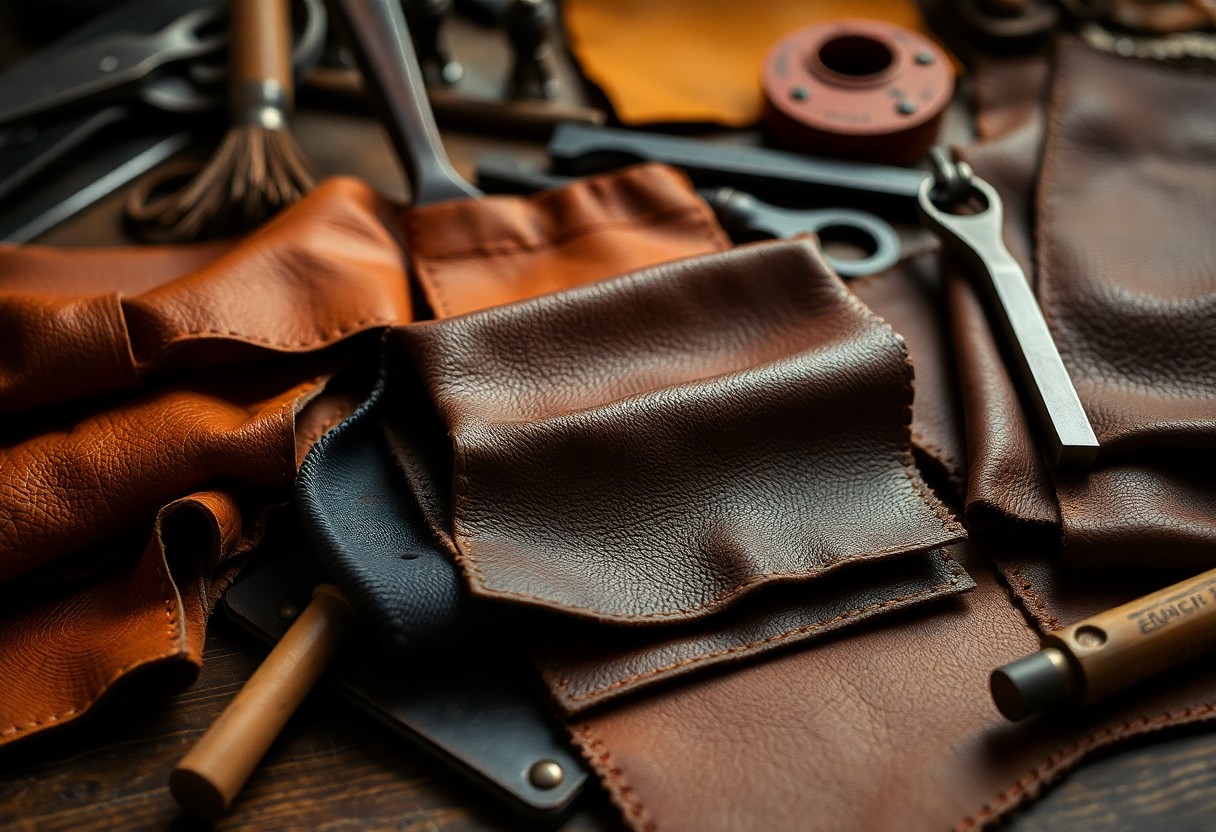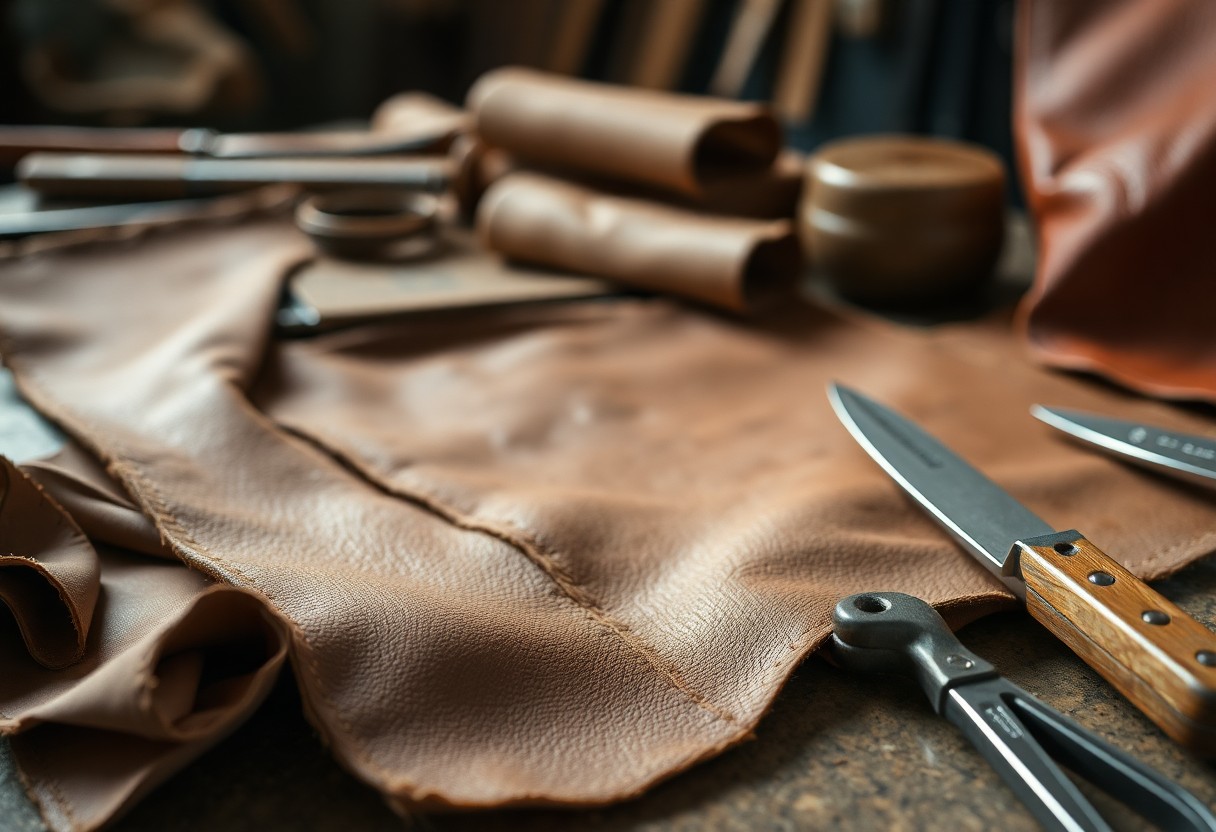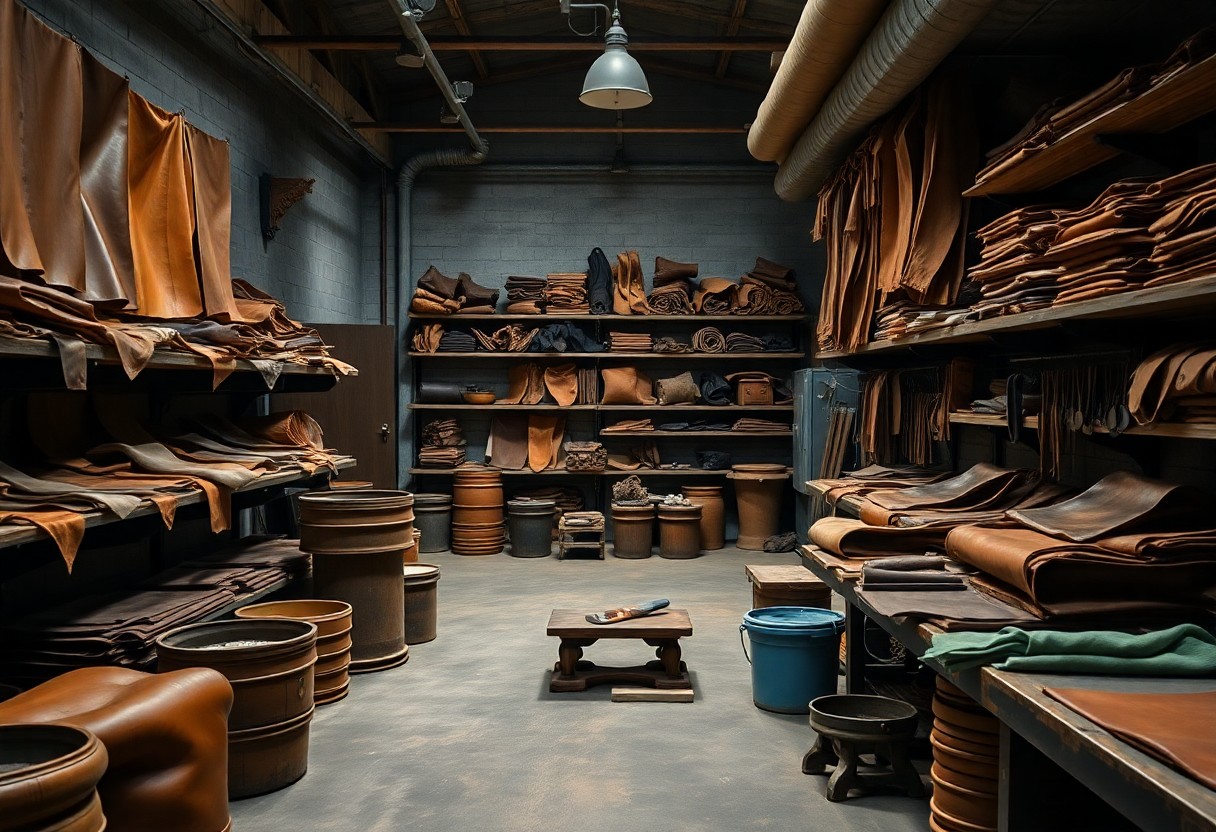
The evolution of leather tanning has transformed it into a highly intricate craft that profoundly influences the overall quality of your leather products. Different tanning techniques result in various characteristics in leather, affecting its durability, water resistance, texture, and color retention. The tanning process begins with raw hides and progresses through vital stages, which may include chrome tanning, vegetable tanning, or chrome-free methods. Each method uniquely shapes the leather's properties, significantly affecting its usability and maintenance. Understanding these processes in depth enables you to make informed decisions about leather quality while also considering the environmental impacts, as some methods are considerably more eco-friendly than others.
Discover the Diverse Techniques of Leather Tanning
Producing high-quality leather involves various tanning methods that transform raw hides into functional leather. The principal techniques include chrome tanning, vegetable tanning, and chrome-free tanning. This extensive guide aims to help you understand the nuances of each process, empowering you to select the method that best aligns with your leather requirements.
| Method | Characteristics |
| Chrome Tanning | Fast, water-resistant, 85% of global production |
| Vegetable Tanning | Natural, eco-friendly, 10% of production |
| Chrome-free Tanning | Environmental-friendly, 5% of production |
| Combination Tanning | Blends multiple methods for unique properties |
| Aldehyde Tanning | Specialized process for specific applications |
Gain Insights into the Chrome Tanning Technique
The chrome tanning method utilizes chromium (III) salts to create leather that is soft, flexible, and highly sought after across various applications. This technique produces leather that is not only water-resistant but also readily accepts dyes, making it a preferred choice within the industry. The efficiency of chrome tanning is impressive, often requiring as little as 24-48 hours to complete, which is essential for meeting mass production demands.
Explore the Timeless Tradition of Vegetable Tanning
As one of the oldest and most traditional methods, vegetable tanning relies on natural tannins extracted from tree bark and leaves. This approach is highly valued for its ability to create leather that matures beautifully, developing a rich patina over time while being biodegradable. Various forms of vegetable tanning, such as those using extracts from oak bark, chestnut, and mimosa, contribute to the distinctive characteristics of the finished product. This labor-intensive process typically takes around 4-6 weeks, resulting in leather that is generally firmer and more structured compared to chrome-tanned leather.

Detailed Overview of the Leather Tanning Stages
Transforming raw hides into premium finished leather involves a systematic and methodical process. Here’s a comprehensive examination of each critical step and its significance in achieving optimal leather quality.
Crucial Pre-tanning Procedures for Superior Quality
To guarantee the highest leather quality, raw hides must undergo a series of thorough preparation steps. This initial phase involves soaking the hides in clean water for 24-48 hours to remove salt and dirt, followed by a liming process that effectively eliminates hair and fats. Maintaining exact pH control during this stage is essential to prevent any damage to the hides and ensure a successful tanning process.
Critical Steps in the Primary Tanning Phase
The pretanning stage commences with deliming and pickling to ready the hides for the main tanning agents. The most widely used method is chrome tanning, which incorporates chromium sulfate and can yield leather in as quickly as 24 hours. Conversely, vegetable tanning employs natural tannins and extends the process to approximately 20-60 days.
Temperature control is another vital aspect of the tanning process. Chrome tanning typically takes place at temperatures of 35-40°C, while vegetable tanning is conducted at lower temperatures of 20-25°C. Consistent monitoring of pH levels is crucial to avoid damaging the leather and ensure optimal absorption of tanning agents, which is essential for achieving the desired quality.
Innovative Leather Treatment Techniques to Enhance Quality
A variety of techniques are available to improve the properties of your leather. From surface finishing to deep penetration treatments, each method serves a specific purpose. With the right treatment, you can extend your leather’s lifespan by up to 50% while significantly enhancing its resistance to water, heat, and wear, thereby maintaining its integrity for years to come.
Examining Various Surface Treatment Options
Surface treatments applied to leather may include waxing, buffing, and protective coatings. These techniques can elevate water resistance by up to 70% and allow for a choice between shiny or matte finishes to suit your preference. Additionally, surface treatments are crucial in protecting leather against UV damage and the wear and tear of everyday use, ensuring that your products remain in excellent condition.
Understanding Dyeing Techniques for Enhanced Color and Durability
Your leather can absorb various types of dyes at different depths, depending on the dyeing method utilized. Aniline dyeing, for instance, penetrates deeply into the leather, while surface dyeing permits a more controlled application of color. The dyeing process you choose will directly impact both the appearance and long-term durability of the leather, determining how well it ages over time.
Moreover, the dyeing technique selected significantly influences the final characteristics of the leather. Drum dyeing can achieve up to 95% color penetration, while spray dyeing provides enhanced precision for color control. It is worth noting that natural dyes are more eco-friendly but may fade approximately 20% faster than their chemical counterparts, making the choice between dye types an important consideration for environmentally conscious consumers.

Key Quality Determinants in Leather Processing
The quality of leather is shaped by a multitude of interconnected factors throughout the processing chain. Understanding these elements is essential for achieving superior results in both leather selection and care. The tanning method, hide quality, and processing parameters all play integral roles in determining the final properties of the leather. By mastering these factors, you will be better equipped to assess leather quality according to your specific needs and preferences.
Choosing Raw Materials for Optimal Leather Quality
When selecting raw materials, focusing on the condition of the hides and the animal source is critical. The quality of your raw materials directly impacts the properties of the final leather product. The best hides typically originate from healthy animals and are characterized by minimal surface defects. Look for consistent thickness and the absence of parasitic damage. Selecting materials based on their intended end-use is vital, as different applications demand specific hide characteristics to ensure optimal performance and durability.
Significance of Processing Parameters in Quality Assurance
There exists a direct correlation between processing controls and the overall quality of leather. Maintaining precise control over pH levels, temperature, and chemical concentrations is critical for achieving the best results. The tanning duration typically spans from 24 to 48 hours, with temperature controls kept between 35-40°C. Diligent attention to these parameters ensures consistent leather quality throughout the entire processing phase.
This meticulous level of oversight should extend to every stage of processing. You must monitor moisture content (ideally 45-55%), maintain appropriate drum speed during tanning, and ensure accurate chemical dosing. Additionally, managing the drying conditions is vital to prevent any damage to the leather. A thorough focus on these parameters ultimately culminates in the production of higher-quality finished leather.
Expert Strategies for Optimal Leather Treatment Outcomes
Not all leather treatment processes yield the same levels of quality. It’s essential to concentrate on temperature control, chemical balance, and timing precision throughout the tanning process to achieve the best results possible.
- Regularly monitor pH levels
- Maintain consistent temperature
- Adhere to exact chemical ratios
- Document each step meticulously
Being aware of the signs of proper tanning can enable you to achieve high-quality finished leather that meets your expectations.
Methods for Process Optimization in Leather Tanning
To achieve optimal results, controlling your tanning environment is crucial. Keep your workspace at temperatures of 20-25°C and maintain humidity levels between 45-55% to ensure ideal conditions. Make sure that your chemical solutions are fresh and accurately measured. Regular maintenance of equipment is vital for achieving consistent results during the tanning process.
Ensuring Quality Standards in Leather Maintenance
The quality of leather is heavily reliant on your storage conditions and handling procedures. Store your leather in a dry, cool area away from direct sunlight to preserve its integrity and prevent deterioration. Regularly check the moisture content and rotate your stock every 30 days to maintain optimal conditions.
Monitoring the tanning process is critical for upholding quality standards. Your routine checks should encompass pH testing, physical inspections, and moisture content analysis. Document all findings and make adjustments to your procedures based on the results. Consistent quality control enables you to identify potential issues before they adversely affect your final product, ensuring high standards are maintained throughout the leather processing journey.

Comparative Analysis of Leather Tanning Techniques
To gain a deeper understanding of leather tanning, it is imperative to evaluate the various methods based on their respective advantages and disadvantages. Below is a comprehensive comparison of the primary tanning techniques:
| Pros | Cons |
|---|---|
| Chrome tanning: Fast processing, cost-effective | Chrome tanning: Environmental concerns, potential disposal issues |
| Vegetable tanning: Eco-friendly, natural process | Vegetable tanning: Time-consuming, requires higher water usage |
| Chrome-free tanning: Environmental safety, good quality | Chrome-free tanning: Complex process, higher costs |
| Combination tanning: Versatile properties | Combination tanning: Challenging quality control |
Economic Considerations of Leather Tanning Choices
Decisions regarding your leather tanning methods can significantly impact production costs. Chrome tanning boasts 85% cost efficiency when compared to vegetable tanning, whereas chrome-free methods often increase expenses by 20-30%. Understanding these economic implications is crucial for effective budgeting and planning within the leather production industry.
Influence of Tanning Choices on Leather Quality
The quality of even the finest leather can be substantially compromised by poor tanning decisions. Your selected tanning method directly influences attributes such as durability, water resistance, and texture, which are essential for the overall performance of the leather.
For instance, leather treated through chrome tanning exhibits superior water resistance and flexibility, making it ideal for various applications, while leather tanned using vegetable methods tends to demonstrate better aging characteristics and develops a unique patina over time, enhancing its aesthetic appeal and value.
Key Takeaways on Leather Tanning and Treatment Techniques
The information presented clearly indicates that various leather tanning and treatment methods profoundly influence the quality and characteristics of your leather. The choice between chrome, chrome-free, or vegetable tanning will significantly shape your leather’s durability, texture, and environmental implications. Additionally, the dyeing technique you opt for—be it aniline or crust—will affect your leather’s color depth and aging process. Finally, the type of finishing applied—whether full grain, corrected grain, or top-coated—sets the standards for appearance, breathability, and maintenance requirements. Gaining a thorough understanding of these processes equips you to make well-informed decisions regarding your leather purchases and care practices, ultimately ensuring satisfaction and longevity.
Your Leather Tanning Questions Answered: FAQs
Q: What are the primary differences between chrome tanning and vegetable tanning?
A: Chrome tanning utilizes chromium salts, resulting in soft, water-resistant leather that is processed quickly and economically. This method accounts for 85% of global leather production. In contrast, vegetable tanning employs natural tannins derived from tree bark and leaves, requiring a longer processing time while producing leather that gains character with age. Although vegetable-tanned leather is more environmentally friendly when it comes to disposal, it is more prone to staining compared to chrome-tanned options.
Q: How does aniline dyeing impact leather quality and appearance?
A: Aniline dyeing involves immersing leather in dye baths that deeply penetrate the material. This technique produces uniform color throughout the leather, providing excellent color retention. Contemporary aniline-dyed leather is often dyed partially through rather than completely, maintaining a lighter middle layer. This approach enhances the leather's stability while ensuring good color depth on the surface, resulting in a more aesthetically pleasing final product.
Q: What distinguishes full grain leather from corrected grain leather?
A: Full grain leather preserves its natural surface without sanding or artificial overlay, showcasing natural pores, the strongest fiber structure, and the ability to be restored when scuffed. On the other hand, corrected grain leather undergoes sanding and is covered with a plastic layer. While corrected grain is easier to clean and maintain, it tends to lack breathability and may crack over time without any means of repair, making full grain leather a more desirable option for quality-conscious consumers.
The Article Guide to leather tanning and treatment methods processes types and their impact on quality appeared first on My Shoes Finder
The Article Leather Tanning: Methods, Processes, and Quality Impact Guide Was Found On https://limitsofstrategy.com





Comments are closed